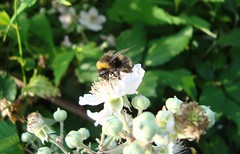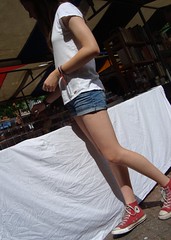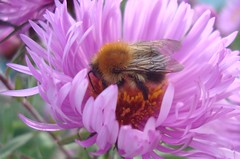Gabriel Waksman's group at the Institute for Structural and Molecular Biology (shared between Birkbeck College and University College London) has an exciting article out in tomorrow's issue of Nature, on the molecular machine which builds pili, i.e. the "hairs" that pathogenic bacteria use to attach themselves to their host. I wrote the following summary for the ISMB website:
The ability of bacteria to cause diseases in humans or animals depends, among other things, on their ability to stick to their host in order to be able to establish an infection. Many kinds of bacteria do this with the help of very thin protein hairs, known as pili. Like our hair, these pili grow from the root. With a detailed structural analysis of how this growth happens, ISMB researchers have now laid the foundations for medical applications.
E. coli strains causing urinary tract infections are one of many examples of bacteria depending on pili, as they would otherwise get washed away with the urine. The outermost end of their type I pili is a sticky protein that attaches itself to the surface of the urinary tract, using the host’s carbohydrate receptors.
Following the pilus from the tip inward, we first find two linker units FimG and FimF and then a large number of copies of the main hair builder, FimA, which is anchored in the outer membrane. In 1999 and 2002, the team of Gabriel Waksmann (then at Washington University Medical School in St Louis, USA and now at the ISMB) showed that these subunits fit together like pieces of a linear jigsaw puzzle. Each protein subunit has a well known structural pattern (the same that is also found in antibodies), but one bit of this structure is missing. The following subunit brings along the missing bit that latches into the hole and completes the structure.
This structural incompleteness of each single subunit means that each of them on its own is unstable in the periplasm, the space between the outer and the inner membrane of certain bacteria (only Gram-negative bacteria have this feature), where pili are manufactured. Therefore, they are being looked after by molecular chaperones, i.e. proteins that can protect these contact points from aggregation.
Now Waksman’s group has elucidated the detailed structure of a complex involving the outermost, “sticky” FimH subunit of an E. coli pilus, as it is being exported through the outer membrane by a specialised protein export machine (the FimD usher) and still being guarded by such a chaperone, FimC. The structure, which shows the pilus tip protein lined up inside a hollow cylindrical channel of the usher protein, is unique in that it is the first such structure of a complete protein export machine including the proper protein to be exported.
Previous biochemical studies had implicated the front end of the usher protein, the N-terminal domain, as a binding site for the pilus proteins to be exported. The new crystal structure, however, shows this site to be idle, while a second site, near the other end of the usher protein, the C terminus, binds the FimH-FimC complex. The authors conclude that the usher has two binding sites such that the growing pilus can remain anchored to one, while the next subunit to be added to it docks to the other.
The authors also conducted a crystallographic analysis of the empty FimD usher for comparison (although the structure of a similar, empty usher, PapC, had been solved before). They found that the binding of the substrate proteins induces a major structural rearrangement. The empty usher has an oval pore sealed by a specific part of the protein, the plug domain, while in the presence of FimH-FimC, the protein adopts a perfectly cylindrical shape, and the plug domain moves out of the way to open the channel for the substrate proteins.
Because this highly complex mechanism by which E.coli and similar bacteria assemble their pili has no equivalent in higher organisms, it appears to be a very promising drug target for new antibacterial therapies. Researchers hope that structural details of this mechanism, such as those revealed in this study, will help them find a way of stopping bacterial hair growth. This may offer a fundamentally new way out of the current crisis caused by drug resistant bacteria, which seem to be spreading ever faster.
The crucial difference is that drugs targeting a non-vital virulence factor such as the assembly of pili, will not kill the bacteria, which has two significant advantages. Firstly, there is less evolutionary pressure in favour of resistance genes, and the evolutionary pressure only applies in the location where the pili would normally anchor the bacteria, e.g. the urinary tract. For the survival of bacteria outside this location, the pili aren’t necessary, so any drugs leaked into the environment don’t breed resistance – in marked contrast to leaked antibiotics.
Secondly, the “disarmed” bacteria may remain present in the organism for long enough to allow our immune system to learn how to fight them most efficiently, such that they act as an immunization against the disease.
Some substances targeted at pilus formation are already under investigation as potential drugs, but the detailed molecular understanding of the process will certainly help to address this target more systematically.
Reference:
G. Phan et al, Nature 2011, 474, 49–53 doi:10.1038/nature10109Background:
Gross M:
Education in Chemistry 2008, 45 No 4, 141-143
Better than antibiotics?
Groß M:
Nachrichten aus der Chemie 2008, 56, Nr 2, 148
Blickpunkt Biowissenschaften: Bakterien am Schopf gepackt






























